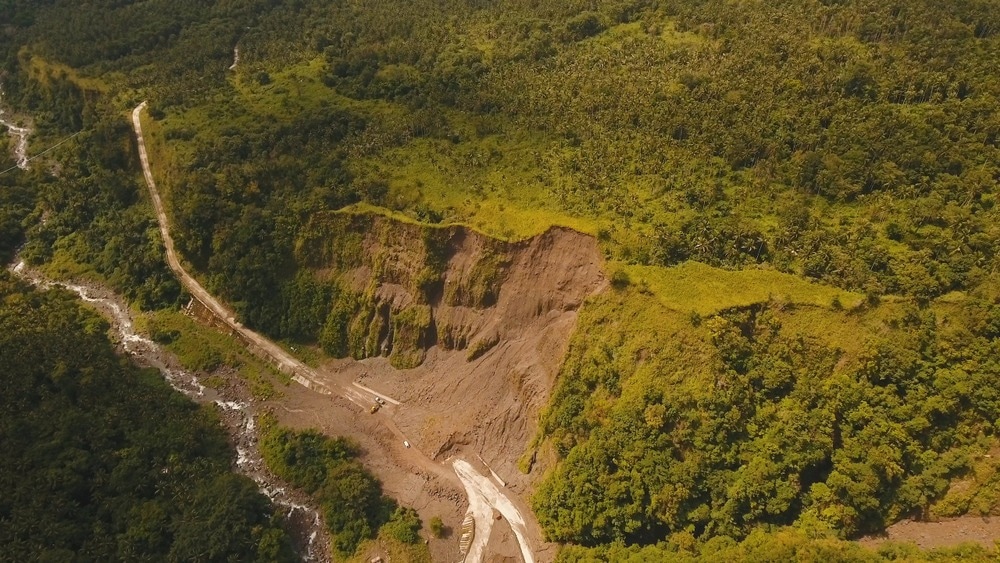A study published in the journal Land proposed a comprehensive landslide monitoring method using the combination of landslide vegetation, surface deformation and susceptibility factors based on spatio-temporal data from various remote sensing sources.

Study: A Spatio-Temporal Monitoring Method Based on Multi-Source Remote Sensing Data Applied to the Case of the Temi Landslide. Image Credit: Alex Traveler/Shutterstock.com
Landslides are challenging to monitor due to their high destructiveness and concealment during their prolonged development. Considering the limitations of traditional landslide monitoring tools, this study proposes a novel approach to landslide monitoring that can help prevent and mitigate natural disasters.
Land Sliding: A Natural Disaster
A landslide is a natural phenomenon in which a portion of a slope slides in shear along one or more faces of the slope due to gravity. Landslides represent a significant safety risk to people's lives and property because of their concealment, suddenness, destructiveness, and widespread effect.
A single landslide can inflict extensive damage. Therefore, timely monitoring and scientific risk assessment before landslide occurrence can effectively reduce potential losses, which is critical for disaster prevention and mitigation.
Land Sliding Monitoring Methods
Landslides are monitored and identified via direct or indirect long-term landslide deformation monitoring.
Direct monitoring of landslides
Direct landslide monitoring techniques include:
- The close shoot method
- The geodetic method
- The Interferometric Synthetic Aperture Radar (InSAR)
- The global navigation satellite system (GNSS)
Close shoot method
The close shoot method involves monitoring two fixed observation points at different positions and analyzing the changes in their locations. It is an effective technique to store measurement data but is susceptible to weather conditions.
Geodetic method
The geodetic method uses optical equipment to accurately measure surface angle and distance. It can measure absolute surface displacement; however, its results are affected by external conditions.
Interferometric synthetic aperture radar (InSAR)
InSAR is the most popular landslide deformation monitoring technique. It offers a wide range, all-weather usage, and excellent accuracy. However, it has a low density of coherent points and unequal spatial distribution in steep terrain and lush vegetation.
Global navigation satellite system (GNSS)
The GNSS approach monitors displacement and deformation by establishing feature points at fixed places and comparing 3D coordinates at varied intervals. This technique gathers data quickly, but the point-by-point basis and interference-sensitive signal make it difficult to reflect surface changes.
Indirect monitoring of landslides
The indirect monitoring of landslides is possible using optical remote sensing. This method compensates for the drawbacks of conventional methods in dynamic environments while successfully saving people and resources.
Each monitoring approach has its benefits and shortcomings, and none of them provides a comprehensive review. Landslide monitoring is a complicated process involving the multidisciplinary interplay of several components.
Therefore, it is essential to develop a novel system for monitoring landslides under complicated situations that considers various aspects from multiple viewpoints and uses multi-source data.
Using Multiple Factors from Time-Series Multi-Data Sources to Design a Landslide Susceptibility Model
Researchers concentrated on changes in three areas: surface deformation information, vegetation condition, and landslide susceptibility.
Firstly, the dimidiate pixel model is used to drive the fractional vegetation cover (FVC) using optical remote sensing Gaofen-1 (GF-1) images. Then, synthetic aperture radar (SAR) remote sensing Sentinel-1A images helped extract the landslide's surface deformation data through the small baseline subsets interferometric synthetic aperture radar (SBAS-InSAR) technique.
The landslide susceptibility model is then generated using the analytic hierarchy process approach employing GF-1, digital elevation model (DEM) data, and Sentinel-1A images. The designed model fully monitors landslides from both a geographical and temporal standpoint.
Finally, the Spatio-temporal relationships between surface deformation data, vegetation condition, and landslide susceptibility are evaluated.
Important Findings of the Study
Landslide susceptibility is not just a geographical or spatial phenomenon. Since many landslide-causing elements are dynamic, landslide susceptibility can be expanded to the temporal dimension to understand temporal changes in a landslide.
The slope has the most significant effect on landslide susceptibility among the parameters used to estimate landslide susceptibility.
According to the analytic hierarchy process (AHP) method's analysis of the Temi landslide, the top portion is more susceptible to landslides, followed by the intermediate and bottom portion.
The surface deformation information, fractional vegetation cover, and landslide susceptibility all show consistency in temporal and spatial dimensions.
As surface deformation progresses, the landslide vegetation deteriorates and susceptibility increases, indicating an increased likelihood of creep and landslides. Conversely, when the surface deformation reduces, the landslide vegetation improves, and the landslide becomes less vulnerable, implying that the risk of sliding decreases.
The landslide vegetation changes as the landslide develop. The fractional vegetation cover of the Temi landslide displays an increasing trend except for the circular arc front edge in the lower main accumulation zone.
Aside from the uplift generated by rivers and other factors, the surface deformation rate due to the Temi landslide's mobility is between -10 and 0 mm/a, indicating that the landslide is now in an exceptionally slow creep phase.
Based on the findings of the Temi landslide, using multi-source data to examine the temporal and spatial correlation of landslide surface deformation, vegetation cover, and susceptibility allows for the successful monitoring of landslide variability. This study helps prevent and mitigate natural disasters and offers a practical approach for monitoring landslides.
Reference
Wang, H., Guo, Q., Ge, X., & Tong, L. (2022). A Spatio-Temporal Monitoring Method Based on Multi-Source Remote Sensing Data Applied to the Case of the Temi Landslide. Land. https://www.mdpi.com/2073-445X/11/8/1367/htm
Disclaimer: The views expressed here are those of the author expressed in their private capacity and do not necessarily represent the views of AZoM.com Limited T/A AZoNetwork the owner and operator of this website. This disclaimer forms part of the Terms and conditions of use of this website.